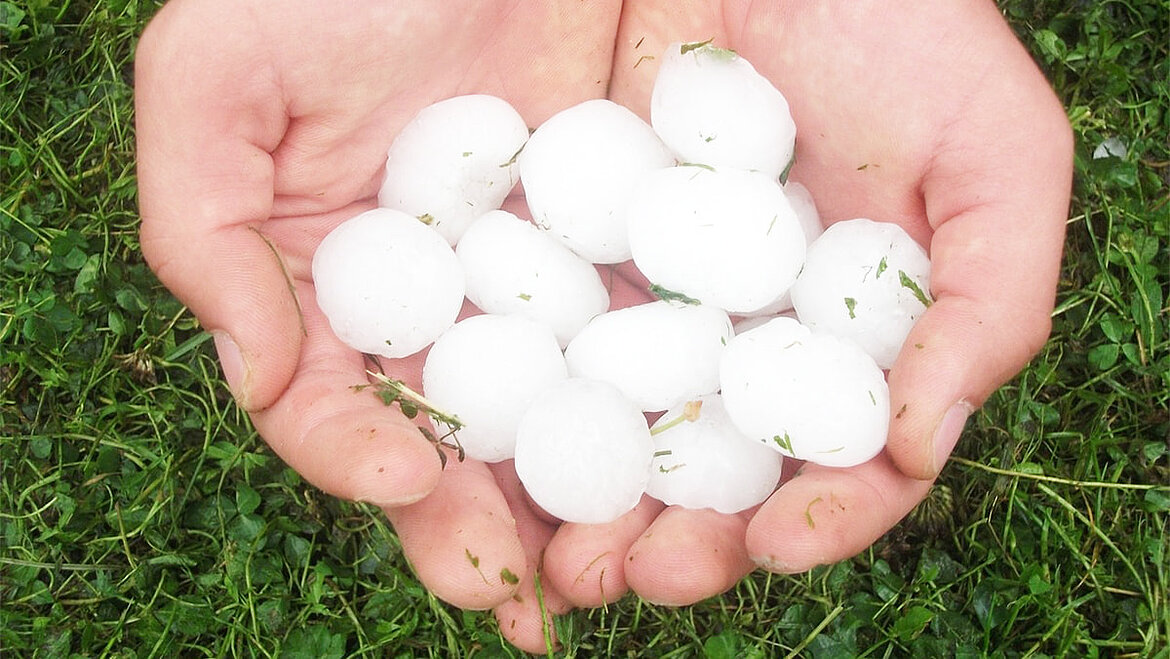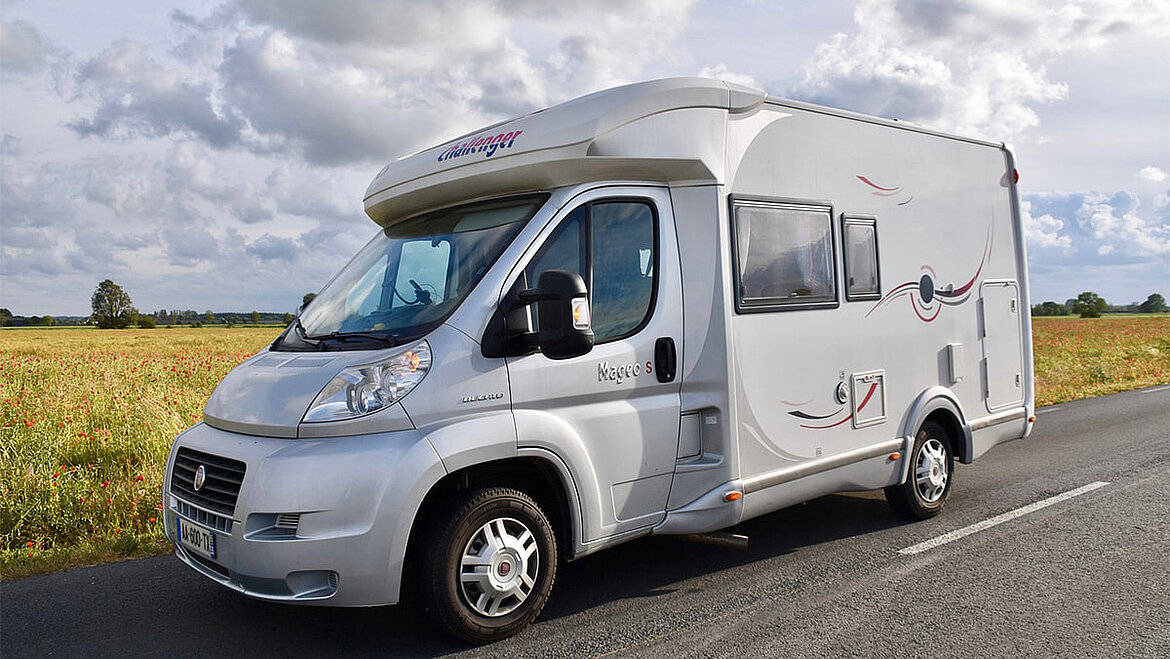It doesn't matter whether the motorhome is parked unprotected at home or campers are travelling in their vehicle – due to the increase in extreme weather events with heavy hailstorms, motorhomes are increasingly subject to severe weather conditions. In recent years, insurance companies have therefore also been notified of more and more damage to the roofs and outer walls of motorhomes. The German Insurance Association (GDV) maintains overall statistics on all vehicle damage, including motorhomes. The storms in 2021 June were the fourth most damaging storm events since 1984. From 18 to 24 June 2021, the whole of Germany suffered several hailstorms, resulting in severe damage to vehicles, especially in Bavaria and Baden-Württemberg. Around 190,000 vehicle damage cases were reported, with a loss expenditure of around 700 million euros. One month later, in July 2021, hailstorm Dirk descended upon Kempten in the Allgäu region and damaged almost one in four insured vehicles, making it the storm with the highest local loss frequency, according to GDV. According to statistics, a total of 40,000 vehicles were damaged in the Black Forest and the affected regions in the Alps, with insurance payouts totalling over 150 million euros.
Aluminium roofs on motorhomes in particular, but also their aluminium side walls, usually suffer large dents from such hail showers, which can be very costly to repair. Experts therefore recommend a GRP outer skin when buying motorhomes, as it is significantly more resistant to hail.
Increasing severe weather due to climate change

Flooding after heavy rain, tornadoes in Germany, prolonged heatwaves and drought periods, as well as extreme weather with severe storms. The weather in Germany, Europe and around the world has been crazy for a number of years. In the coming years, the German Weather Service (DWD) is even expecting a further increase in extreme weather events, i.e. even more storms, extreme rainfall and heatwaves. According to studies by various climate researchers, this is due to rising temperatures as a result of climate change.
In recent years, the European Storm Institute (ESSL) has also recorded an increase in storms with much more hail damage, due to more, and above all, unusually large hailstones. Hail conditions are on the increase, especially in Europe. On 19 July 2023, a 16-centimetre-diameter hailstone was found in Carmignano di Brenta in northern Italy – a new European record. However, just a few days later, also in northern Italy, this record find was usurped by a hailstone with a diameter of 19 centimetres. For comparison purposes: a standard football has a diameter of 21 centimetres.
Hail – what is it and how is it created?
Hailstones are ice crystals that fall to the ground. Hail showers are increasingly common, especially during the warmer seasons. This is because in summer, warm and humid air rises and meets cold air, creating small droplets. Because the air in the clouds is usually below freezing temperatures, the water freezes to form small ice crystals. Air currents in the clouds cause the ice crystals to be repeatedly thrown upwards even further, i.e. into even colder air, and then back down again.
They absorb even more drops of water and ice crystals. When the upwind and downwind become weaker and can no longer carry them, the little ice balls fall down to the ground. The stronger the upwinds, the larger the hailstones, specifically: Heavy thunderstorms produce much larger hailstones and the larger they are, the greater their downward velocity. For example, grains with a diameter of 5 centimetres fall from the sky at a speed of around 110 kilometres per hour. Hailstones with a diameter of about 12 centimetres plummet to the ground at around 170 kilometres per hour.
Please note: The term hail is used only if the grains are greater than 0.5 cm in diameter. For anything smaller than this, the term sleet is used. The largest hailstone in the world was found in South Dakota. It had a diameter of 20.3 cm. The largest hailstone in Germany was found in Baden-Württemberg in 2013 and had a diameter of 14 centimetres.
Destructive power of hail
If thunderstorms strike, there is a greater risk to life and limb. Due to climate change, hailstones can grow to be above average in size, so it is advisable to be safe and stay at home during thunderstorms. Storms and hail can cause great damage. Uprooted, fallen trees, demolished cars or destroyed roofs and hose facades are not uncommon. More and more motorhomes are also being damaged by falling hailstones, which leave a very costly calling card. Dents in the roof and side walls, destroyed roof hoods and damaged solar systems are just a few examples.
A case for insurance
It is therefore important for campers to insure their motorhomes against hail and natural disasters. Fully comprehensive and most semi-comprehensive insurance policies also cover this damage. However, to ensure that the insurance companies bear liability, the damage should be documented immediately in the form of photos and videos, the date, time and location of the hail damage noted and everything reported immediately. Damaged roof hoods must also be covered so that possible rain showers do not cause damage to the interior of the vehicle. The respective insurance company then commissions an appraiser to look directly at the damage to the motorhome and assess it, thereby determining the type of repair and the extent of the damage. Hail damage is separated into three different categories – light, medium and heavy. The decisive factor here is the number of dents per square metre, their depth and diameter. It is also noted whether the material that has been damaged is aluminium or GRP. Since GRP is generally much less fragile than aluminium and can also be repaired even more easily, some insurance companies even offer special premiums for GRP roofs and outer walls. A comparison of aluminium and GRP can be found here.
GRP material for roof and side wall

GRP materials offer even more advantages, which is why motorhomes with GRP roofs and outer walls are particularly popular with campers. GRP is not only very resistant to hail storms, but also UV, weather and non corrosive. GRP producer LAMILUX Composites also manufactures these glass fibre-reinforced plastics based on polyester and epoxy resin, which are used as panels in the caravan industry.
All renowned motorhome manufacturers worldwide rely on GRP applications from LAMILUX applications, as GRP is more impact- and corrosion-resistant than aluminium, but also features a lower weight, which reduces CO2 emissions and also fuel consumption.
LAMILUX X-treme is ideal for roof applications as it provides reliable resistance to hail damage thanks to its exceptional impact resistance and damage tolerance. But all motorhome aficionados know that the motorhome's appearance is particularly important – even after many years. LAMILUX SUNSATION® applied as an outer wall is an absolute innovation on the caravan market.
This GRP face sheet not only features the best colour and gloss retention in the world, but also boasts 20 times greater UV stability compared to standard gel coat systems, which means that the motorhome still looks like new even after many years in the sun. Please note: LAMILUX GRP panels can also be used in motorhomes in doors, floors, as an antislip covering for external storage lockers or as interior wall cladding.
This protects the motorhome against hail damage
As the entire outer shell of motorhomes can be made up of GRP materials, these motorhomes probably offer the highest level of protection against hail storms. A GRP roof can also be retrofitted to the motorhome at a later date. Other options for protecting the motorhome include self-adhesive hail protection films, a PVC foam protective roof or Durabull™ coatings, i.e. special roof coatings that can be used as a preventive measure, but can also be used to repair existing hail damage. Special winter covers are can also be created, which not only protect the motorhome from rain, snow and cold, but also from minor hail damage, thanks to their special padding. In principle, however, it is true to say: The larger the hailstones, the less protection all the solutions mentioned offer against the unwelcome dents. In this case, a garage or carport to accommodate the motorhome will probably provide the best protection.
Advantages of motorhomes with GRP coating
In summary, it can be said that extreme weather events will become more common in the future due to climate change. For example, motorhomes are increasingly exposed to heavy hailstorms. In order to avoid as far as possible unpleasant hail damage to the roof and side wall of the motorhome, GRP materials are recommended for these areas, as they are particularly resistant to hail. Many well-known motorhome manufacturers rely on GRP applications from LAMILUX Composites. Some insurance companies even offer special premiums for motorhomes with GRP roofs and outer walls.



